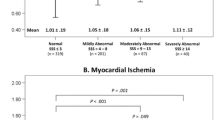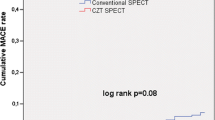Abstract
Background
Little is known about the prognostic value of myocardial perfusion single photon emission computed tomography (SPECT) in patients with remote prior myocardial infarction (MI).
Methods and Results
We identified 1413 consecutive patients with remote prior MI who underwent rest-stress myocardial perfusion SPECT. Semiquantitative visual analysis of 20 SPECT segments was used to define the summed stress, rest, and difference scores. The number of non-reversible segments was used as an index of infarct size. During follow-up (≥1 year), 118 hard events occurred: 64 cardiac deaths (CDs) and 54 recurrent MIs. Annual CD and hard event rates increased significantly as a function of SPECT abnormality. For summed stress scores less than 4, 4 to 8, 9 to 13, and more than 13, the annual CD rates were 0.4%, 0.9%, 1.7%, and 3.5%, respectively (P = .002). Patients with small MI (<4 non-reversible segments) and no or mild ischemia (summed difference score ≤6) had an annual CD rate of 0.6%. Patients with small MI and moderate or severe ischemia had an annual CD rate of 1.6%, and those with large MI (≥4 non-reversible segments) had moderate to high annual CD rates (3.7%-6.6%) regardless of the extent of ischemia. Nuclear testing added incremental prognostic information to pre-scan information. Compared with a strategy in which all patients are referred to catheterization, a strategy that referred only those patients with a risk for CD of greater than 1% by myocardial perfusion SPECT resulted in a 41.6% cost savings.
Conclusions
Myocardial perfusion SPECT adds incremental value to pre-scan information and is highly predictive and cost-efficient in the risk stratification of patients with remote prior MI. Patients with normal or mildly abnormal scan results or small MI in combination with absent or mild ischemia have a low risk for CD.
Similar content being viewed by others
References
Berman DS, Hachamovitch R, Kiat H, Cohen I, Cabico JA, Wang FP, et al. Incremental value of prognostic testing in patients with known or suspected ischemic heart disease: a basis for optimal utilization of exercise technetium-99m sestamibi myocardial perfusion single-photon emission computed tomography. J Am Coll Cardiol 1995;26:639–47.
Hachamovitch R, Berman DS, Kiat H, Merz CNB, Cohen I, Friedman JD, et al. Exercise myocardial perfusion SPECT in patients without known coronary artery disease. Circulation 1996;93:905–14.
Hachamovitch R, Berman DS, Shaw LJ, Kiat H, Cohen I, Cabico JA, et al. Incremental prognostic value of myocardial perfusion single-photon emission computed tomography for the prediction of cardiac death. Circulation 1998;97:535–43.
Mahmarian JJ, Mahmarian AC, Marks GF, Pratt CM, Verani MS. Role of adenosine thallium-201 tomography for defining long-term risk in patients after acute myocardial infarction. J Am Coll Cardiol 1995;25:1333–40.
Dakik HA, Mahmarian JJ, Kimball KT, Koutelou MG, Medrano R, Verani MS. Prognostic value of exercise Tl-201 tomography in patients treated with thrombolytic therapy during acute myocardial infarction. Circulation 1996;94:2735–42.
Berman DS. Use of 201Tl for risk stratification after myocardial infarction and thrombolysis. Circulation 1997;96:2758–61.
Basu S, Senior R, Raval U, Lahiri A. Superiority of nitrate-enhanced 201Tl over conventional redistribution 201Tl imaging for prognostic evaluation after myocardial infarction and thrombolysis. Circulation 1997;96:2932–7.
Travin MI, Dessouki A, Cameron T, Heller GV. Use of exercise tech-netium-99m sestamibi SPECT imaging to detect residual ischemia and for risk stratification after acute myocardial infarction. Am J Cardiol 1995;75:665–9.
Brown KA, Heller GV, Landin RS, Shaw LJ, Beller GA, Pasquale MJ, et al. Early dipyridamole (99m)Tc-sestamibi single photon emission computed tomographic imaging 2 to 4 days after acute myocardial infarction predicts in-hospital and postdischarge cardiac events: comparison with submaximal exercise imaging. Circulation 1999;100:2040–2.
Ladenheim ML, Pollock BH, Rozanski A, Berman DS, Staniloff HM, Forrester JS, et al. Extent and severity of myocardial hypoperfusion as predictors of prognosis in patients with suspected coronary artery disease. J Am Coll Cardiol 1986;7:464–71.
Staniloff HM, Forrester JS, Berman DS, Swan HJC. Prediction of death, myocardial infarction, and worsening chest pain using thallium scintigraphy and exercise electrocardiography. J Nucl Med 1986;27:1842–8.
Berman DS, Kiat H, Friedman J, Wang FP, Van Train K, Matzer L, et al. Separate acquisition rest thallium-201/stress Tc-99m sestamibi dual isotope myocardial perfusion SPECT: a clinical validation study. J Am Coll Cardiol 1993;22:1455–64.
Mark DB, Shaw L, Harrell FE Jr, Hlatky MA, Lee KL, Bengston JR, et al. Prognostic value of a treadmill exercise score in outpatients with suspected coronary artery disease. N Engl J Med 1991;325:849–53.
Braunwald E, Mark DB, Jones RH, Cheitlin MD, Fuster V, McCauley KM, et al. Unstable angina: diagnosis and management. AHCPR publication number 94-0602. Rockville (MD): Agency for Health Care Policy and Research, US Department of Health and Human Services; 1994.
Diamond GA, Staniloff HM, Forrester JS, Pollock BH, Swan HJC. Computer-assisted diagnosis in the noninvasive evaluation of patients with suspected coronary artery disease. J Am Coll Cardiol 1983;1:444–55.
Hastie TJ, Tibshirani RT. Generalized additive models. Stat Sci 1986;1:297–318.
Shaw LJ, Hachamovitch R, Berman DS, Marwick TH, Lauer MS, Heller GV, et al. The economic consequences of available diagnostic and prognostic strategies for the evaluation of stable angina patients: an observational assessment of the value of precatheterization ischemia. Economics of Noninvasive Diagnosis (END) Multicenter Study Group. J Am Coll Cardiol 1999;33:661–9.
Brown KA, Weiss RM, Clements JP, Wackers FJ. Usefulness of residual ischemic myocardium within prior infarct zone for identifying patients at high risk late after acute myocardial infarction. Am J Cardiol 1987;60:15–9.
Breithardt G, Borggrefe M, Fetsch T, Boecker D, Maekijaervi M, Reinhardt L. Prognosis and risk stratification after myocardial infarction. Eur Heart J 1995;16(Suppl G):10–9.
Deedwania PC, Amsterdam EA, Vagelos RH. Evidence-based, cost-effective risk stratification and management after myocardial infarction. Arch Intern Med 1997;157:273–80.
American College of Physicians. Guidelines for risk stratification after myocardial infarction. Ann Intern Med 1997;126:556–60.
Peterson ED, Shaw LJ, Califf RM. Risk stratification after myocardial infarction. Ann Intern Med 1997; 126: 561–82.
Risk stratification and survival after myocardial infarction. Multicenter post-infarction research group. N Engl J Med 1982; 306: 1065–70.
Sanz G, Castaner A, Betriu A, Magrina J, Roig E, Coll S, et al. Determinants of prognosis in survivors of myocardial infarction: a prospective clinical angiographic study. N Engl J Med 1982; 306:1065–70.
Sharir T, Germano G, Kavanagh PB, Lai S, Cohen I, Lewin HC, et al. Incremental prognostic value of post-stress left ventricular ejection fraction and volume by gated single photon emission computed tomography. Circulation 1999; 100: 1035–42.
Berman DS, Kang X, Van Train KF, Lewin HC, Cohen I, Areeda J, et al. Comparative prognostic value of automatic quantitative analysis versus semiquantitative visual analysis of exercise myocardial perfusion single-photon emission computed tomography. J Am Coll Cardiol 1998; 32: 1987–95.
Author information
Authors and Affiliations
Corresponding author
Additional information
Supported, in part, by a research grant from DuPont Pharma, which
Supported, in part, by a research grant from DuPont Pharma, which
Rights and permissions
About this article
Cite this article
Zellweger, M.J., Dubois, E.A., Lai, S. et al. Risk stratification in patients with remote prior myocardial infarction using rest-stress myocardial perfusion spect: prognostic value and impact on referral to early catheterization. J Nucl Cardiol 9, 23–32 (2002). https://doi.org/10.1067/mnc.2002.118925
Received:
Accepted:
Issue Date:
DOI: https://doi.org/10.1067/mnc.2002.118925




